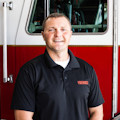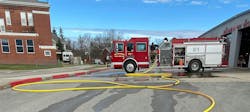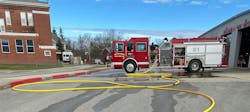Small-City Grab: A Story of Preparation and Success
The account below is meant to drive discussion, share success and reiterate the overall importance of size-up and training. Although the physics and chemistry of fire don’t change between incidents, we must remember that resources, particularly staffing, do. Strategies and tactics must match the hand that we are dealt in the moment.
Somewhere everyday
I long have considered myself a student of our craft, and I don’t believe that mindset ever will change. Those who spent time around me during the past three years probably heard me use the phrase “somewhere everyday.” It has become my personal rallying cry for staying on top of my game. It was adopted from the name of the sculpture at the IAFF Fallen Fire Fighter Memorial of a firefighter carrying a child down a ladder. The phrase has carried me through days when I didn’t feel like working out, moments when I was bored, and even a period of time during which I doubted my skillset and abilities. Looking back now, it was this steadfast belief that one day “somewhere” would be a scenario for which I or my crew had prepared.
Coordination is key
It was Sunday, Nov. 27, 2022, and nearing time for shift change. Daylight hadn’t broken yet, and those of us who were on duty hadn’t emerged from the bunkroom. An oncoming firefighter was preparing the morning coffee. Before the morning laughter could fill the bay, tones broke the silence: a structure fire in the heart of a residential area in our small city. Everybody quickly donned their gear. We were out the door with a four-person crew, one more than we typically have and two more than our minimum.
As we raced down the mostly empty streets, the dispatcher notified us that the fire was reported to be “fully involved” and eventually relayed reports of “confirmed entrapment.” This wasn’t my first fire with entrapment, but it was by far the closest to the firehouse in my 16 years at that time. (Our combination department covers 50-plus square miles out of a single firehouse.) I began to give out arrival instructions, which were more of a reminder, for those who were on board. We just had to plug in the extra firefighter.
Each of us came off of the engine ready for their piece of the battle. Lt. John Brugnoli, who was driving, is a seasoned firefighter who has experience in multiple departments. The driver of the first-in apparatus with our resources must be willing and able to go to work after setting the pump: recognizing the need for ventilation, ladders or additional extinguishment from the exterior, all while providing information to the next incoming units. After exiting the engine, Brugnoli immediately went to work.
Limited staffing & water on fire
Brugnoli made the decision to knock down the visible fire and get as much water into the house as possible using the deluge gun. This was a tactic that we employed several times previously to quickly stop fire growth and to begin extinguishment while our initial line was being deployed. We trained on it, timed it and set our engines up for it with gate valves on all of the deluge guns. Ultimately, Brugnoli’s action knocked down nearly all of the exterior fire on the porch and made some progress on the interior.
Firefighter Maria Potter knew that she was responsible for putting a handline on the fire to knock down everything that she could and to protect the search. Her job was made easier thanks to hundreds of hours of work and to funding from our city to redo our attack packages. A decade prior, Potter’s options would have been 125 gpm at 100 psi through a 1¾-inch line or 250 gpm at 100 psi through a 2½-inch handline. Without hesitation, she reached for the new low-pressure hose that was tipped with a smoothbore and found a position that both protected the stairwell and was able to reach nearly all of the fire on the first floor.
Have your TIC
Both Brugnoli’s and Potter’s actions took place as a search was initiated by me and Firefighter 1st Class Ethan Smith.
My size-up started as we arrived and continued as I jogged across the front of the house. The structure was two stories, approximately 2,400 sq. ft., with the front entry on the Alpha/Bravo corner, as it is on many other houses in our small city. Past experience told me that stairs would be near the door.
The front porch and the front of the first floor was involved in fire. The second floor was showing signs of extension.
We were headed to find a rear entrance when EMTs ran up to us and relayed information from the patients who they were treating: One person was in the house in a first-floor bedroom.
We located a rear entrance on the Bravo/Charlie corner and made our way inside. Smith quickly located the closed door to the bedroom, and I followed him in, closing the door behind us. The bedroom was in near-pristine condition. Much to our dismay, the room was clear, just as was the area that was immediately outside of it.
I communicated to Smith that we would search toward the front of the house, to ensure that the person wasn’t between the bedroom and the front door.
When we exited the bedroom and Smith began to search ahead of me, I quickly scanned the area ahead with the thermal imaging camera (TIC). The front of the structure still showed at hotter than 600 degrees Fahrenheit.
After searching the kitchen, which was immediately in front of us, we paused for a few seconds to wait on the initial line to make it into the house. No scan was needed to feel the cooling effect that stream had on the first floor as Potter made her push.
Smith searched into the front rooms. I communicated to him that I would search to where the stairs should be located.
When I was near the front door, I scanned ahead with my TIC to get a confirmed location of the stairs, and I made my way up them. The person was located on the porch roof, having exited a second-floor window that was taken by the deluge gun.
Learning and improving
Although the story doesn’t end with me locating the stairs, it’s everything that happened up to that point and the speed at which it happened that allowed for the outcome.
My department had been busy for years laying a foundation and improving its capabilities for the day that we would be needed to fulfill our mission at its highest level. We learned from previous fires.
Our small city added more career staffing in the previous years, because without a quick response, the odds would be stacked against us further.
We changed our hose and hose loads and moved to low-pressure nozzles, so minimal firefighters could begin to extinguish a fire in a residential dwelling.
We trained on quickly operating a deluge gun and deploying hose. We trained on building layouts and searching with our staffing levels.
Most importantly, we didn’t let the small size and makeup of our department affect our belief that we can save lives and protect property when we respond to residential fires.
About the Author

Joey Baxa
Joey Baxa has been a firefighter for 15 years. He currently holds the rank of captain with the Buckhannon, WV, Fire Department. Baxa also is an instructor with Insight Training LLC and is an adjunct instructor with West Virginia University Fire Service Extension.

